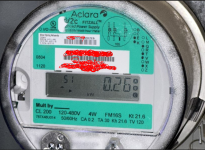You are using an out of date browser. It may not display this or other websites correctly.
You should upgrade or use an alternative browser.
You should upgrade or use an alternative browser.
Meter ampacity
- Thread starter julianov
- Start date
- Status
- Not open for further replies.
- Location
- New Jersey
- Occupation
- Journeyman Electrician (retired)
I would guess that it's 200 amps but wonder why do you need to know this:?
kwired
Electron manager
- Location
- NE Nebraska
- Occupation
- EC
Usually is the POCO's issue to need to know this, but I have run into non POCO owned meters that owner uses for their own monitoring purposes at times. Common one here is old farm place where there is a house and grain storage on the site but occupant of the house is not the one storing the grain - was at one time when occupant was the one farming the place but they maybe retired, passed away, or whatever and now someone else is farming the place but does not live there. Not necessarily legal to sell power if you are not the POCO, but nothing wrong with using it to help determine how to split the bill. Whoever the account owner is still ultimately has responsibility of making sure bill is paid or both users are subject to no power if they are disconnected for non payment.I would guess that it's 200 amps but wonder why do you need to know this:?
I have a few mechanical meters around I acquired from a nearby POCO when they switched to all digital meters and occasionally install one for the situation I described above.
It is solely for study purposes. I won't take any action based on it, but I am beginning to study the NEC. From what I have observed, 'CL' refers to the meter's class. Therefore, if it is CL 20, it can measure up to 20 amps and if it is CL 200 it can measure up to 200 amps.I would guess that it's 200 amps but wonder why do you need to know this:?
- Location
- Illinois
- Occupation
- retired electrician
You won't find any of that in the NEC...for the most part the NEC does not care about meters....they are just a "bump" in the service entrance conductors.It is solely for study purposes. I won't take any action based on it, but I am beginning to study the NEC. From what I have observed, 'CL' refers to the meter's class. Therefore, if it is CL 20, it can measure up to 20 amps and if it is CL 200 it can measure up to 200 amps.
hillbilly1
Senior Member
- Location
- North Georgia mountains
- Occupation
- Owner/electrical contractor
Just a side note, but the A B C on the far right of the display makes it easy to determine if a phase loss is on the poco side, without having to suit up in PPE. If one or more is flashing or out, the fault is on the poco side.Hello All.
I've a question about the meter ampacity. To know the meter ampacity I must see the tag CL? for example the next picture show a meter of 200 Amps because it is CL 200, right?
View attachment 2569322
- Location
- New Jersey
- Occupation
- Journeyman Electrician (retired)
Just my 2 cents but if you're studying the NEC you should skip the meter altogether.It is solely for study purposes. I won't take any action based on it, but I am beginning to study the NEC. From what I have observed, 'CL' refers to the meter's class. Therefore, if it is CL 20, it can measure up to 20 amps and if it is CL 200 it can measure up to 200 amps.
If your studying the NEC there is no need to “know” a meter that well. We (poco) decide what meter goes where. Ive had CL 200 meters on a 400 amp service. The 200 amp rating is continuous. That FM16S is a self contained three phase.It is solely for study purposes. I won't take any action based on it, but I am beginning to study the NEC. From what I have observed, 'CL' refers to the meter's class. Therefore, if it is CL 20, it can measure up to 20 amps and if it is CL 200 it can measure up to 200 amps.
a CL 20 meter is instrument rated only. They are used for CT Metered installation's. 3S for single phase, now days 9S for three phase.
WAY back when the instrument rated meters would only handle 5 amps. You had to size the CTs to the loads. Therefore all CTs were sized 50:5, 100:5, 200:5, xxx:5, etc to make the selection process easy. With CTs today you can overload them to a certain point and still register correctly. CL20 meters allow 20 amps, or four times the CT rating. It never works out to use a ct at four times rating. They won’t handle it.
i would stick to infinitys advice and forget the metering for now
electrofelon
Senior Member
- Location
- Cherry Valley NY, Seattle, WA
- Occupation
- Electrician
Not disagreeing with others that these meter details are not an NEC issue and I would think would not be on any licensing test..... But for completeness, if you want to learn more about electric meters, also investigate the meter "form", i.e. 2S, 3S.....
- Status
- Not open for further replies.


